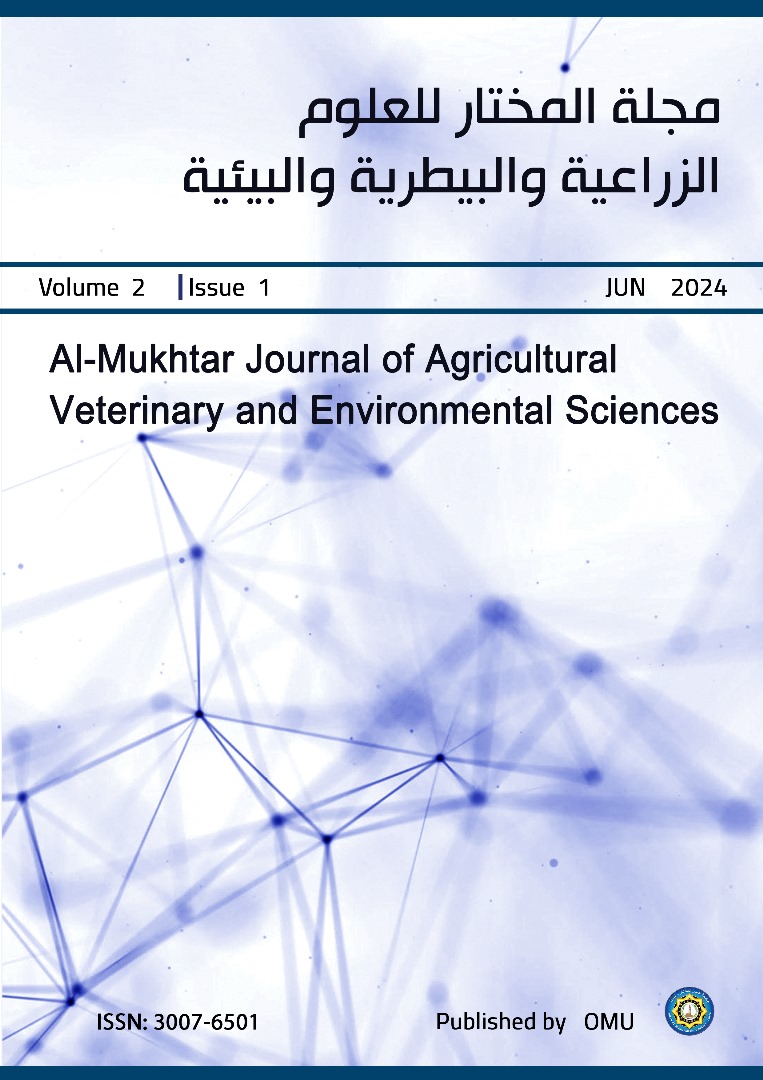Effect of Cold Stratitication and Gibberellic Acid Treatment on Seed Germination and Seedlings Growth of Quince (Cydonia oblonga)
DOI:
https://doi.org/10.54172/7f71bw13Keywords:
Quince, Stratification, dormancy, GA3Abstract
The study aimed to determine the effect of cold stratification, concentrations of gibberellic acid (GA3) and the interaction between them on the characteristics of germination and growth of quince seedlings. Quince seeds have embryonic dormancy attributed to inhibitory germination in seed covers; thus, seeds exposed to cold stratification (30, 60, and 90 days) and treated with GA3 at concentrations (0, 250, 500, and 1000 ppm). A randomized complete block design was used, and each treatment contained 40 seeds. The results showed the cold stratification of 90 days gave the highest percentage and speed of germination, the longest seedling, the largest leaf area and a percentage of dry matter with an average of (87%, 1.88, 37.35cm, 31cm2 and 55%), and the use of a concentration (500 ppm) gave the best percentage and speed for seed germination. The interaction showed a significant effect on the characteristics of germination and growth. The seed treated with cold stratification for 60 days with a concentration of GA3 at 500 ppm gave the highest percentage of germination (94%), and the stratification for 90 days with a concentration of 1000 ppm recorded the largest leaf area and the highest percentage of dry matter (34. 40 cm2 and 57.54%) on respectively. While the seeds stratified for 60 days without GA3 have the highest value for the diameter (2.89 mm). From this, we concluded that the treatment with GA3 with cold stratification is of economic importance for its effective role in breaking the dormancy of Quince seeds.
References
Ali, A. S., & Elozeiri, A. A. (2017). Metabolic processes during seed germination. Advances in seed biology, 141-166.
Castro-Camba, R., Sánchez, C., Vidal, N., & Vielba, J. M. (2022). Plant development and crop yield: The role of gibberellins. Plants, 11(19), 2650.
Chen, S. Y., Chou, S. H., Tsai, C. C., Hsu, W. Y., Baskin, C. C., Baskin, J. M &Kuo-Huang, L. L. (2015). Effects of
moist cold stratification on germination, plant growth regulators, metabolites and embryo ultra-structure in seeds of Acer morrisonense(Sapindaceae). Plant Physiology and Biochemis-try, 94, 165-173.
Chen, S. Y., Kuo, S. R., & Chien, C. T. (2008). Roles of gibberellins and abscisic acid in dormancy and germination of red bayberry (Myrica rubra) seeds. Tree Physiology, 28(9), 1431-1439.
Chen, S.Y.; C.T. Chien; J.D. Chung; Y.S. Yang & Kuo, S.R. (2007). Dormancy– break and germi-nation in seeds of Prunus campanulata (Rosaceae): role of covering layers and changes in concentration of abscisic acid and gibberellins. Seed Sci. Red. 17: 21-32.
Einali, A. R., & Sadeghipour, H. R. (2007). Alleviation of dormancy in walnut kernels by moist chilling is independent from storage protein mobilization. Tree Physiology, 27(4), 519-525.
El-Yazal, S. S., EI-Shew, A. A. E. M., & EI-Yazal, M. A. S. (2021). Impact of seed cold stratifica-tion on apricot germination and subsequent seedling growth as well as chemical constituents of seeds during stratification. Horticult. Int. J, 5(4), 151-157.
Finkelstein, R., Reeves, W., Ariizumi, T., & Steber, C. (2008). Molecular aspects of seed dorman-cy. Annu. Rev. Plant Biol., 59, 387-415.
Ge, N., Jia, J. S., Yang, L., Huang, R. M., Wang, Q. Y., Chen, C & Chen, J. W. (2023). Exogenous gibberellic acid shortening after-ripening process and promoting seed germination in a me-dicinal plant Panax notoginseng. BMC Plant Biology, 23(1), 67.
Guo, C., Shen, Y., & Shi, F. (2020). Effect of temperature, light, and storage time on the seed ger-mination of Pinus bungeana Zucc. ex Endl.: the role of seed-covering layers and abscisic acid changes. Forests, 11(3), 300.
Han, C., & Yang, P. (2015). Studies on the molecular mechanisms of seed germina-tion. Proteomics, 15(10), 1671-1679.
Hashemirad, S., Soltani, E., Darbandi, A. I., & Alahdadi, I. (2023). Cold Stratification Require-ment to Break Morphophysiological Dormancy of Fennel (Foeniculum vulgare Mill.) Seeds Varies with Seed Length. Journal of Applied Research on Medicinal and Aromatic Plants, 100465.
Hopkins, K. A., & Gravatt, D. A. (2019). Effects of cold stratification and hormones on seed ger-mination of Sarracenia alata. Texas Journal of Science, 71(1), Article-7.
Kafkas, S., Imrak, B., Kafkas, N. E., Sarıer, A., & Kuden, A. (2018). Quince (Cydonia oblon-ga Mill.) Breeding. In Advances in Plant Breeding Strategies: Fruits (pp. 277-304). Springer, Cham.
Lee, M. H., Song, C. H., Park, C. H., Song, K. S., Kim, S. Y., Kim, S. H., & Na, C. S. (2022). Ef-fect of gibberellic acid treatment and alternating temperature on breaking physiological dor-mancy and germination in Penthorum chinense Pursh (Penthoraceae). Seed Science and Technology, 50(2), 207-219.
Leida, C., Conejero, A., Arbona, V., Gómez-Cadenas, A., Llácer, G., Badenes, M. L., & Ríos, G. (2012). Chilling-dependent release of seed and bud dormancy in peach associates to com-mon changes in gene expression. PLoS One, 7(5), e35777.
Lewak, S. (2011). Metabolic control of embryonic dormancy in apple seed: seven decades of research. Acta physiologiae plantarum, 33(1), 1-24.
Li, L., & ROSS, J. D. (1990). Starch synthesis during dormancy breakage in oilseed of Corylus avellana. Annals of Botany, 66(5), 507-512.
Li, Q. F., Zhou, Y. U., Xiong, M., Ren, X. Y., Han, L., Wang, J. D & Liu, Q. Q. (2020). Gibberellin recovers seed germination in rice with impaired brassinosteroisignalling. Plant Science, 293, 110435.
Miransari, M., & Smith, D. L. (2014). Plant hormones and seed germination. Environmental and ex-perimental botany, 99, 110-121.
Mohammadi, S., B. Baninasab, A.H. Khoshgoftar Manesh, & A. Ghasemi. (2015). Responses to quince, pear and hawthorn rootstocks to iron deficiency in soilless culture. Sci. Technol. Greenhouse Crops. 20:127–137.
Naylor, R. E. L. (1981). An evaluation of various germination indices for predicting differences in seed vigour in Italian ryegrass. Seed Science and Technology (Netherlands).
Nedunchezhiyan, V., Velusamy, M., & Subburamu, K. (2020). Seed priming to mitigate the impact of elevated carbon dioxide associated temperature stress on germination in rice (Ory-za sativa L.). Archives of Agronomy and Soil Science, 66(1), 83-95.
Nimbolkar, P. K., Awachare, C., Reddy, Y. T. N., Chander, S., & Hussain, F. (2016). Role of root-stocks in fruit production–a review. Journal of Agricultural Engineering and Food Technol-ogy, 3(3), 183-188.
Ott,. L., & Longnecker M.T. (2015). An introduction to statistical methods and data analysis: Nel-son Education. 1296.
Peters, P. (2000). Tetrazolium testing handbook. Contribution No. 29. The hand book on seed test-ing. Prepared by tetrazolium subcommittee of the association of official seed analysis. Part2. Lincoln, Nebraska.
Rawat, B. S., Khanduri, V. P., & Sharma, C. M. (2008). Beneficial effects of cold-moist stratifica-tion on seed germination behaviors of Abies pindrow and Picea smithiana. Journal of Forest-ry Research, 19(2), 125-130.
Samaan, L. G., El-Baz, E. E. T., Iraqi, M. A., & El-Dengawy, E. F. A. (2000). Effect of gibberellic acid treatments on seed dormancy, germination and subsequent seedling growth of apricot (Prunus armeniaca L.). Egyptian Journal of Horticulture, 27(2), 141-156.
Sondheimer, E., Tzou, D. S., & Galson, E. C. (1968). Abscisic acid levels and seed dormancy. Plant Physiology, 43(9), 1443-1447.
Su, L., Lan, Q., Pritchard, H. W., Xue, H., & Wang, X. (2016). Reactive oxygen species induced by cold stratification promote germination of Hedysarum scoparium seeds. Plant Physiolo-gy and Biochemistry, 109, 406-415.
Tatari, M., Rezaei, M., & Ghasemi, A. (2020). Quince Rootstocks Affect Some Vegetative and Generative Traits. International Journal of Fruit Science, 20(sup2), S668-S682.
Wang, Y., Zhang, J., He, W., Yang, S., & Wang, X. (2020, February). Effect of Gibberellin Treat-ment on Dormancy-breaking and Germination of Cherry Seeds. In IOP Conference Series: Earth and Environmental Science (Vol. 446, No. 3, p. 032079). IOP Publishing.
Willis, C. G., Baskin, C. C., Baskin, J. M., Auld, J. R., Venable, D. L., Cavender‐Bares, J., & NES-Cent Germination Working Group. (2014). The evolution of seed dormancy: environmental cues, evolutionary hubs, and diversification of the seed plants. New Phytologist, 203(1), 300-309.
Yamauchi, Y., Ogawa, M., Kuwahara, A., Hanada, A., Kamiya, Y., & Yamaguchi, S. (2004). Acti-vation of gibberellin biosynthesis and response pathways by low temperature during imbibi-tion of Arabidopsis thaliana seeds. The Plant Cell, 16(2), 367-378.
Downloads
Published
Issue
Section
License
Copyright (c) 2024 Abaidalah A. Saleh, Khalid M, Mazik (Author)

This work is licensed under a Creative Commons Attribution-NonCommercial 4.0 International License.













